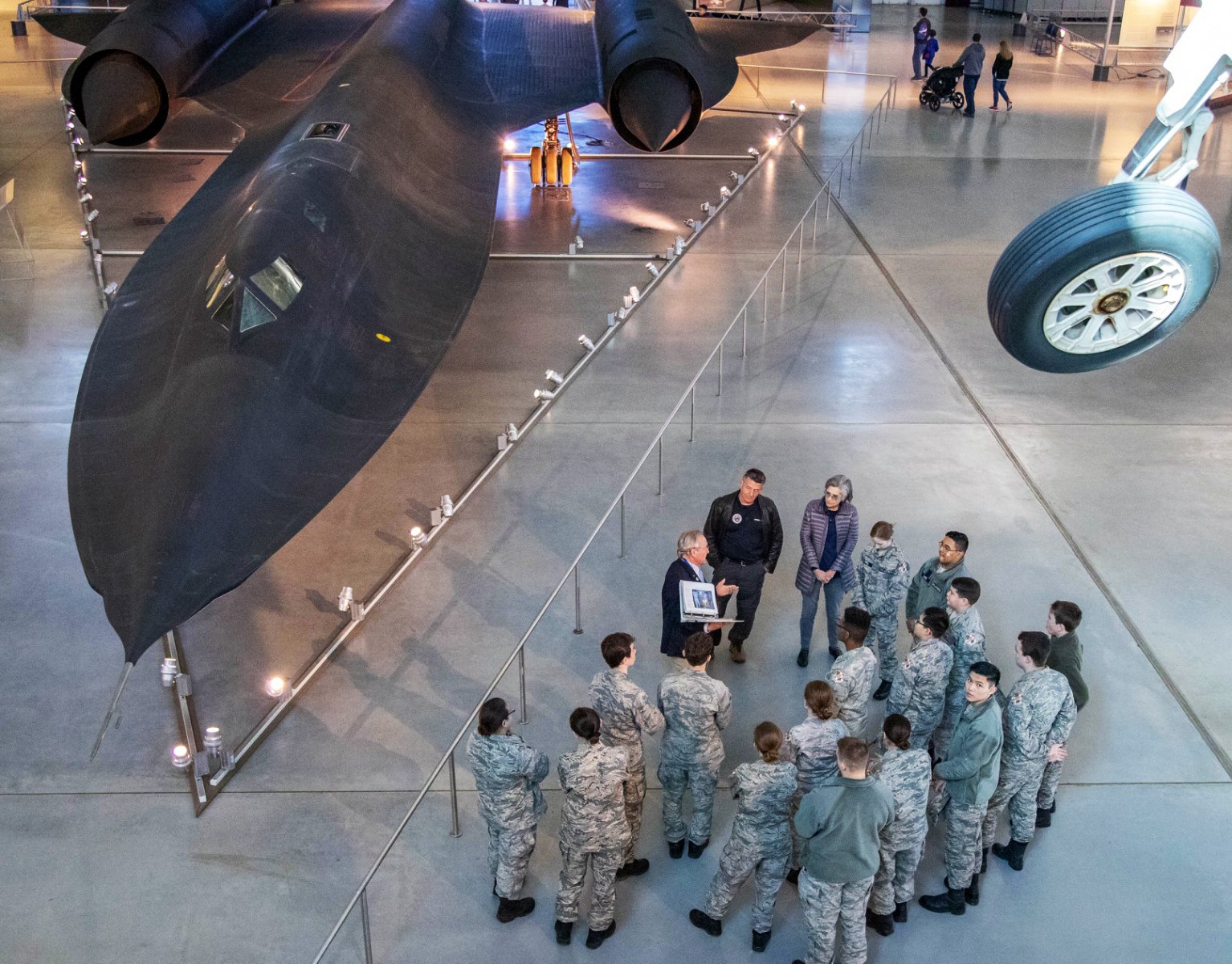Md. Cadets Explore Aviation History on Museum Visit
Senior Member Maria Esparraguera
Assistant Activities Officer
Harford Composite Squadron
Maryland Wing
 From the minute 16 cadets in the Maryland Wing’s Harford Composite Squadron walked into the Smithsonian National Air and Space Museum's Udvar-Hazy Center, aviation history surrounded them.
From the minute 16 cadets in the Maryland Wing’s Harford Composite Squadron walked into the Smithsonian National Air and Space Museum's Udvar-Hazy Center, aviation history surrounded them.
Soon after they entered the sprawling complex in Chantilly, Virginia, near Dulles International Airport, the cadets  could be found gawking at a sleek SR-71 Blackbird. As they did so retired U.S. Air Force Col. Adelbert “Buz” Carpenter – a former SR-71 pilot who now serves as a docent at the museum – talked to them about the plane, its history and its capabilities.
could be found gawking at a sleek SR-71 Blackbird. As they did so retired U.S. Air Force Col. Adelbert “Buz” Carpenter – a former SR-71 pilot who now serves as a docent at the museum – talked to them about the plane, its history and its capabilities.
The plane’s beginnings dated back to President Dwight D. Eisenhower’s recognizing that U.S. spy planes flying over the Soviet Union during the Cold War had shown up on radar, Carpenter told the cadets. The president wanted a high-flying, undetectable reconnaissance plane, and with the SR-71 he got it.
Not one of the 35 SR-71s was lost to enemy forces, Carpenter said. The jet flew 35 miles per minute, or over 2,000 mph.
Carpenter showed pictures of his view of Earth from 80,000 feet in the SR-71. The Blackbird got so hot that the cockpit’s glass windows often reached more than 500 degrees, he said, and he couldn’t touch them for long, even in his flight suit.
The titanium plane expanded so much at speed from the heat that it leaked a lot of fuel when it taxied on the ground at lower temperatures. The cadets learned the plane used a special fuel that would not catch fire at higher temperatures.
Carpenter also talked about the aircraft’s positioning system, which used the stars as guides with amazing accuracy. He handed the group his folder of flight pictures and said the plane could accurately photograph a similar folder from 80,000 feet.
He loved to play tricks on air traffic controllers who may not have been familiar with the SR-71’s call sign, “Aspen,” he said. He recalled once requesting a flight level of six-zero-zero, or 60,000 feet – far above the reach of general aviation aircraft.
The controller asked how Carpenter would climb to that level. He replied that it wouldn’t take long to descend to flight level six-zero-zero. There was a long pause. Then the controller said, “Aspen, cleared as requested.”
Carpenter told the cadets to “dream high” and to never lose their dreams. He recalled hearing about the unique planes while attending the Air Force Academy, little knowing that eight years later he would be able to fly them. It was something he dreamed about, he said.
After that the cadets tore themselves away from the SR-71 and toured the helicopters.
Several cadets knew the Cobra, Huey and Chinook. One of the senior members accompanying them, 2nd Lt. Samuel Thomas, a retired U.S. Army aviator who’s the Harford squadron’s deputy commander for cadets, had flown the AH-1 Cobra. He told the group the reason it had flat-paneled windows was to minimize the sun’s reflection and the chances of being seen by the enemy.
The Cobra carried tube-launched, optically tracked, wire-guided missiles. When launched, the shooters had to keep the target in the crosshairs in order to keep the missile on track.
Wires actually extended from the missile and could become entangled in the helicopter blades or rotors if maneuvered in a certain way after launch. Pilots could not see the wires and had to ensure the chopper did not descend into their path or risk entanglement. The wires were automatically cut after 3,000 meters.
The weapons effectively balanced the complex design, and the Cobras had much success during many conflicts, Thomas said,
The group also viewed the Cessna 180 “Spirit of Columbus,” piloted by the first woman to fly solo around the world, Jerrie Mock, who carried out the flight in 1964 in a skirt and hose. At one airport in Asia, officials didn’t want to let her back across the flight line because they didn’t believe she was actually the pilot.
The cadets also saw the Virgin Atlantic Global Flyer – the first plane to fly one person, pilot Steve Fossett, around the world without stopping to refuel. He did it in just over 67 hours from Feb. 28-March 2, 2005. The plane held 2,915 gallons of fuel, accounting for 83 percent of the aircraft’s maximum weight.
They also saw Japanese tokko-tai (special attack unit) planes, also known as kamikaze. The model they saw, Ohka (Cherry Blossom) Model 22, was designed to allow a pilot with minimal training to drop from a Japanese navy bomber and guide his warhead-equipped aircraft at high speed into an Allied warship. More than 5,000 pilots died making these attacks.
Photos by 2nd Lt. Michelle Travers





